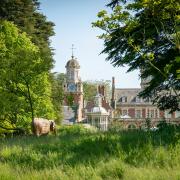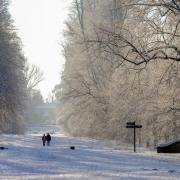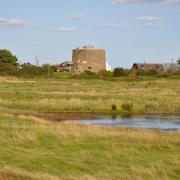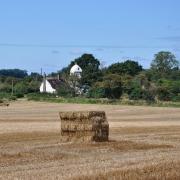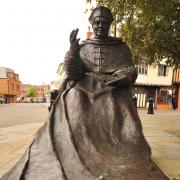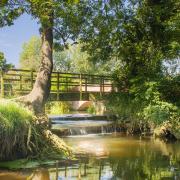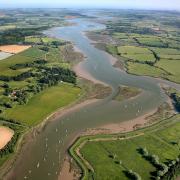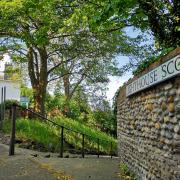Lindsay Want drinks in the contented country landscapes immortalised by writer Adrian Bell’s wartime literary portrait, Apple Acre, on a station to station walk through the farmlands of north Suffolk from Brampton to Beccles

Just across the Westhall fields from Cox Common and Paradise Farm, the modest little platforms of Brampton station sit in splendid isolation even by Suffolk standards. There’s a handful of houses, and rumours of a mysterious mound and a neighbouring moated manor, but its village namesake is nowhere to be seen.
Northwards along the lanes, Redisham is a straightforward stride away, once the hamlet home of writer Adrian Bell (1901-1980), a clever farming chappie who took time out to pen portraits of a community content to draw its strength from the land – when he wasn’t puzzling things out as the first compiler of The Times crossword.

These days, the 1940s Suffolk smallholdings and orchards of his book, Apple Acre, have been hard pressed to survive the ‘big field’ mentality of modern farming. But when it comes to the crunch, old ways and signs of those accepting, practical, living-with-the-seasons times about which he wrote, are somehow ever-present in the lie of the land.
Shingle Hall, Sandy Lane, Gorse Thick, Blue Tile Farm, The White House, New Wood, Second Wood, Eight Acre Covert – the local labels are simply descriptive, matter of fact, honest, unpretentious, real. Here, perhaps more significantly than in any other Suffolk patch, the clue is in the name.

Take a walk through Brampton’s great fields and Redisham Hall’s historic parklands, past Ringfield’s commons and idyllic country church, all the way to St Michael’s magnificent belfry in the heart of Beccles, and you’re sure to get a feel for how Mr Bell’s observations still ring true.
From Brampton railway station’s cherished platform, go over the level crossing and along the road, past the paddocks and Victorian houses to a sharp right bend.

Ignore the road and Road Farm (I said the clue’s in the name around here) to follow the footpath sign and go straight ahead. Cross a field passing close to a wooded mid-field pond. Look back and there are views beyond Westhall’s Mill Common to the more modern windmills turning where wartime propellers once did at old Holton aerodrome. Beyond the pond, meet a hedge in the corner of the field.
Perhaps Shingle Hall (on the left here) was the hallowed home of unexpected aggregates within these heavy clay farmlands? Continue straight ahead, across the fields, on the line of the first and third electricity poles, making for a hedged corner. Follow the hedge to the road, cross over and continue straight on, hedge-hugging until you reach a footbridge.

Over the sleeper bridge next, to continue on the other side of the hedge. On the right are enclosed fields, bordered with woodlands and views towards a white watertower. At the path junction snake right, at the next one, left to pass in front of Wood Farm and down a straight field-edge bridleway towards… (well, I never…) Great Wood.
Turn right and a beautiful bridleway runs along the first wood pastures which suggest that Redisham Hall is not too far away. By Gorse Thick, the tussock-y meadow with its deeply incised stream and occasional veteran oak soon opens out into an expanse of parkland with the red roof of the hall just peeping above the trees.

The bridleway becomes a wider ride through a shady patch, before leading down to the gamekeeper’s cottage, past the horses, hens and the smart walled garden (left).
You’ll find plenty of clues in names at Redisham Hall – and also none at all. First up, the Grade II listed, 19th century mansion isn’t technically in Redisham at all, but in the parish of Ringsfield. John Garden built it in 1823 to replace an Elizabethan pile and it was entirely titivated and re-faced by John Lewis Garden (don’t even bother trying to google that name!) in the 1880s. A big game hunter, J.L. Garden Esq. had to content himself with just 400 acres of deer park at home. He did net himself an interesting American wife though, but more of that later.
Garden once by name, and garden by nature - Redisham Hall is now home to a plant nursery and its beautiful borders, walled kitchen gardens, peach house and vinery have opened annually through the National Gardens Scheme for over 50 years. There must still be an apple orchard in there somewhere, if only to honour the Garden family motto proudly displayed above the doorway – “Press on!”
And indeed you must. Where the main drive swerves right, follow the footpath straight ahead, through a gate into the parkland with a deep-cut, ha-ha like stream-bed and the Hall to the left. Further on, somewhere beyond them, the remnants of a St James’ Church reputedly hide behind the trees, but which village it adhered itself to is even more of a mystery.
Another gate leads from parkland to a real ‘Apple Acre’ meadow, high in its hedges, rich in its wildflowers. East Suffolk’s ‘Akenfield’ would be jealous.
The bridleway continues left, across a wooden bridge (not ahead across rough ground), eventually taking in an enclosed recreational meadow - Ringsfield Common - which going by the name of the adjacent farm, was possibly once used to pen animals. Meet historic Pound Farm, its pond and hoppy hedgerows by the road, after ducking and diving through the greenery and bearing left after the footbridge. Follow Redisham Road left to Ringsfield Corner.
Here on green, the village sign is more of a modern conundrum. Was this the home of some war-like, norse-looking, local Lord of the Rings? And is that just a black bird - or a fieldfare or ringed plover?! - apparently exercising on a hamster wheel. It all feels a bit like one of Adrian’s Times crossword clues - elusive.
Muse on, hanging a left down School Road and just past the (yes, you’ve guessed it …) school, take the bridleway (right). Even without a friendly quadruped to ride on, you somehow feel high up here. It seems a treasured green path, bordered now by hedges, leading left then right by Kiln Covert, eventually looking down across the fields towards Ringsfield church tower amongst the treetops. At the bottom of the hill, go right down towards Old Hall Farm.
Ah, Ringsfield Church. Curious, thatched and nestling next to Old Hall – surely the apple of the eye of any walker on this juicy little country route. Like so many Suffolk churches it’s full of surprises inside and out.
There’s the flamboyant memorial to local princess, Caroline Murat, great niece of Napoleon and grand-daughter of the King of Naples - hardly an expected find, but the American lovely was tracked down by that local big game hunter and lived out her life at Redisham Hall. Round the back there are beautiful brasses and a terracotta mermaid bearing all, and inside an almost extinct specimen – a cheekily carved and painted ‘Laudian’ pulpit and screen from the time of Charles I.
Coming out of the churchyard, turn left, following the road right for about 120 metres (150 yards), then take the bridleway right, uphill towards Lodge Farm, with undulating field views back down towards the church hamlet. Opposite the farm buildings head right down the bridleway, following the track left round the bend, parallel here with John John’s Wood and the world which rolls away towards Barsham Marshes and the River Waveney. Keep right of the hedge to reach a sharp corner in Ringsfield Road.
Don’t venture down the road, but instead turn left along a leafy sunken trackway which eventually leads past houses and down to the Angles Way Path opposite heavily haunted Roos Hall on the busy B1062 Bungay Road.
And Beccles seems to rise out of nowhere. Cross the B1062 with care, turning right along the grass verge path, to then drop down left into deliciously named Puddingmoor. Here Cliff House Steps lead up to the Beccles Museum (12), the town’s great 16th century belfry (13) bought for a penny from St Michael’s by the Borough in the 1970s and over to the station (14), for trains back across the ‘Apple Acre’ landscapes to Brampton station.
Need to know:
Distance: 6.75 miles (11kms)
Time: About 3-4 hours
Start: Brampton train station
Getting there / back: www.nationalrail.co.uk / www.suffolkonboard.com /Free station car park at Brampton.
Finish: Beccles train station for return to Brampton.
Is it for me? Field-edge, cross-field and wooded paths; some soft ground; some tarmac roads or pavement. Gentle inclines. Gates. Fully waymarked. Stout footwear a must.
Directions & Mapping: East Suffolk Line Walks Booklet www.eastsuffolklinewalks.co.uk
Big Map to hand: OS Explorer 231 & OL40
Ts & Ps: Pub in Ringsfield (short detour from village sign). Public conveniences plus pubs, cafés and shops in Beccles.




